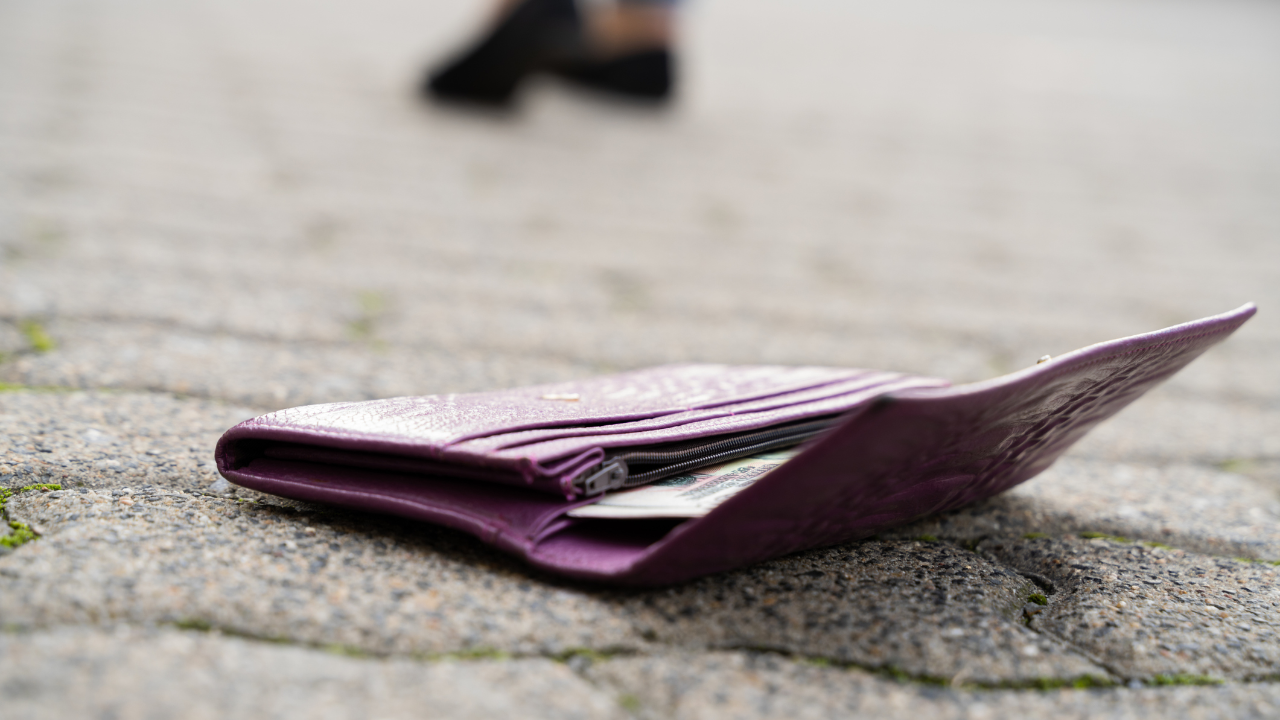How to replace a lost or stolen credit card

The Bankrate promise
At Bankrate we strive to help you make smarter financial decisions. While we adhere to strict , this post may contain references to products from our partners. Here's an explanation for . The content on this page is accurate as of the posting date; however, some of the offers mentioned may have expired. Terms apply to the offers listed on this page. Any opinions, analyses, reviews or recommendations expressed in this article are those of the author’s alone, and have not been reviewed, approved or otherwise endorsed by any card issuer.
Key takeaways
- If your credit card has been lost or stolen, don't panic — there are steps you can take immediately to keep your account and credit profile safe.
- Start by reaching out to your credit card issuer and freezing your account, either by calling them or by using your card's mobile app.
- If you're sure you can't find it, or if you've found fraudulent charges on your account, have your issuer cancel the card and issue you a replacement.
- In the meantime, take steps with the three major credit bureaus to protect yourself from potential identity theft and other issues that could hurt your credit score.
That plastic rectangle in your wallet or purse may look small, but it can present a large problem if it’s misplaced, stolen or compromised. That’s because a thief can quickly rack up unauthorized charges and possibly harm your credit unless you take swift action.
That’s why it’s crucial to take a lost or stolen credit card seriously. Here, we’ll explore what to do if you notice unauthorized charges, including how to contact your credit card issuer and the major credit bureaus, when it’s best to file a police report, when to consider a security freeze on your credit file and other best practices you can adopt to safeguard your credit cards.
First, take a deep breath. One of the major benefits of a credit card is that the fraud protections are strong. You just need to know how to handle the situation.
Why it’s important to take a stolen or lost credit card seriously
It’s bad enough when you realize the cash in your wallet has gone missing — but it’s even worse when you can’t find your credit card, either. In the wrong hands, your credit card can be used for unauthorized transactions that can add up to hundreds or even thousands of dollars.
“If someone gets their hands on your card, they can rack up charges that amount to a hefty bill. This could result in financial strain. If your card is stolen, it could be used for fraudulent activities, which could damage your credit score and financial reputation.”
— Baruch SilvermannPersonal finance expert
Renee Robinson-Jones, vice president of Product Management for Georgia’s Own Credit Union, agrees. “Thankfully, most credit card issuers are diligent about making you whole when you’ve experienced fraud on your account,” she says. “However, if you haven’t found your card within a reasonable amount of time, it’s crucial that you take action.”
Per federal law, if you report a credit card loss before someone else uses it, you are not obligated to cover any unauthorized charges or withdrawals occurring thereafter. But if you delay reporting the loss or theft and someone has already used your card without permission, you may be liable up to $50, according to the Federal Trade Commission.
What to do if your card is lost or stolen
If you can’t find your credit card, start by following these simple steps:
Step 1: Retrace your steps
Before tearing apart your home while you search, check your credit card account for any unusual activity to ensure it isn’t being used by a bad actor.
“If you notice no unusual activity, retrace your steps. Think back to the last transaction when you physically swiped your card or held it in your hand for an online purchase. Ask others in your household who may also have access to your card,” suggests Robinson-Jones.
Take the time to search carefully through your home and belongings.
“Check your pockets, bags and places you have recently visited. Your card may be simply misplaced and not stolen,” Silvermann adds.
Step 2: Contact your credit card issuer
If you’ve noticed fraudulent charges or still can’t find your card after searching high and low, it’s time to reach out to the issuer of your credit card. That means phoning them or contacting the issuer via their website or mobile app.
If your card is lost but you don’t yet want to cancel the card, you can opt for a card lock, also called a card freeze. This halts new purchases on your credit card account while still permitting recurring automatic transactions like subscriptions or bills.
“Most issuers allow you to do this instantly through their mobile at or via their 24/7 fraud line. Locking your card will give you peace of mind while you continue to search for it or wait for a replacement,” Robinson-Jones continues.
But if you’re sure your card has been stolen or is permanently lost, you can request for the issuer to cancel, not lock, the card. They’ll then issue you a replacement card. Here are the contact options for some of the major credit card issuers:
-
You can report a lost or stolen Amex card by calling 800-528-4800 or logging into your online account. Amex also offers the option to freeze your card online or through its mobile app.
-
To report a lost or stolen Barclays card, call 877-523-0478, or lock your card online or via their mobile app.
-
Report a lost or stolen Capital One card at 800-655-2265. Capital One provides online and mobile options to lock your card as well.
-
To report a lost or stolen Chase card, call 800-432- 3117. Chase also allows you to lock your card online or via their mobile app.
-
Call 800-950-5114 to report a lost or stolen Citi card. You can also lock your card online or through the Citi mobile app.
-
You can report a lost or stolen Discover card by calling 800-347-2683 or by logging into your online account. Discover also allows you to freeze your card online or through their mobile app.
-
You can report a lost or stolen Wells Fargo card simply by calling 800-869-3557. Or check their website or mobile app for options to lock your card.
-
To speak with a representative about your lost or stolen Bank of America credit card, call 800-732-9194. Like others on this list, you can also go into Bank of America’s mobile app to lock the card.
Step 3: Request a replacement card
Most credit card issuers will automatically send you a replacement card with a new credit card number if you report the card lost or stolen, unless you want to close the account permanently and decline a replacement card.
“But you will still want to verify that you will be receiving a new card with a new number, and when you can expect it,” Robinson-Jones advises.
Requesting a replacement card also presents a chance to enhance your card. While making the request, consider inquiring about upgrading your new card with modern features such as contactless payment or potentially opting for a card offering improved or alternative rewards that align with your spending habits. You can also opt for paperless statements, receive purchase notifications and even enroll in credit report alerts.
Step 4: File a police report if you believe the card was stolen
Convinced your card was stolen? Filing a report with your local police department can be an important step for documenting the theft and providing evidence in case of fraudulent activity. It can also help law enforcement track down the perpetrator.
“Even if you think it’s just a case of a misplaced card, it’s better to have a record of the incident in the event things escalate. Plus, some credit card companies might require a copy of the police report.”
— Mike SchmidtAttorney, Schmidt & Clark LLP
Step 5: Contact the major credit bureaus
Even though you’ve already reported the loss or theft of your card to your issuer, it’s smart to set up an initial fraud alert with the major credit bureaus: Experian, Equifax and TransUnion.
“This alerts creditors to verify your identity before extending you credit. This extra layer of security can help prevent identity theft,” Silvermann notes.
To set up a fraud alert, visit one of the fraud alert pages for Experian, Equifax or TransUnion.
“This service is free and you only need to reach out to one of the three agencies; they will contact the other two when you set up a fraud alert,” says Robinson-Jones.
Step 6: Set a security freeze on your credit file
If you suspect that you may be the victim of identity theft and want added protection beyond a fraud alert, you can set a security freeze on your credit file for no charge.
“This will prevent thieves from opening new credit in your name, which is crucial,” Robinson-Jones adds.
Visit the security freeze pages for TransUnion, Equifax, and Experian to implement a credit freeze.
Step 7: Review your card statements
Once you’ve taken the above steps, continue to regularly monitor your credit card statements for any unauthorized charges or suspicious activity.
“Report any discrepancies you notice to your credit card issuer immediately,” suggests Silvermann.
Step 8: Update your automatic bill payments
As soon as you receive your replacement credit card, be sure to update any automatic payments connected to that account with your new card information.
“If payment deadlines occur while the new card is in transit, be sure to make other arrangements, as missing payments can hurt your credit score – adding further complications to an already stressful situation,” says Robinson-Jones.
Step 9: Monitor your credit reports
Access your Experian, Equifax and TransUnion credit reports for free at AnnualCreditReport.com and carefully review each report for accuracy. You can request up to one credit report per week.
“Reviewing your credit report allows you to spot any unauthorized accounts or inquiries and take appropriate action,” says Silvermann.
How to protect your credit cards going forward
Even if you aren’t dealing with a lost or stolen card, it’s a good idea to follow credit card best practices that can safeguard your account and prevent loss and fraud. Try these tips:
- Use alerts. Most credit card issuers have the option to set up transaction alerts via text or email message. Sign up for this feature to receive real-time notifications for any suspicious or unusual activity on your accounts.
- Use digital tools. Take advantage of free resources available to help you protect your identity in credit. For example, Chase Credit Journey offers free credit and identity monitoring, including alerts, regardless of whether you have a Chase account.
- Log on safely. “Whether you are at a coffee shop or an airport, consider avoiding conducting personal business when connected to public Wi-Fi. Use complex passwords when creating logins for highly sensitive accounts, like your credit card,” recommends Darius Kingsley, head of Consumer Business Practices for JPMorgan Chase & Co.
- Consider mobile wallet options. “A mobile wallet can tokenize transactions, requiring a password or bio recognition, and limit the need for you to carry a physical card that can be lost or stolen,” says Robinson-Jones.
- Be careful with mail and bills. “Consider switching to paperless options for your credit card. Collect your mail every day and put it on hold when you are away on vacation with family or friends,” adds Kingsley.
The bottom line
Don’t procrastinate if your card is missing or you think it’s in the hands of a thief. Contact your issuer immediately and consider further steps you can take to protect your credit. The good news is that swift action can prevent you from having to pay for unauthorized charges and shield your credit from significant damage.
Related Articles


Ways your credit card info might be stolen and how to prevent it

